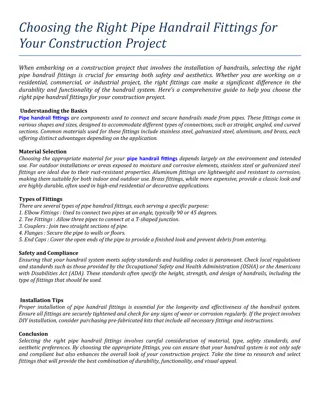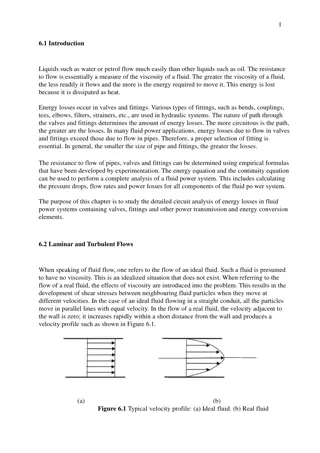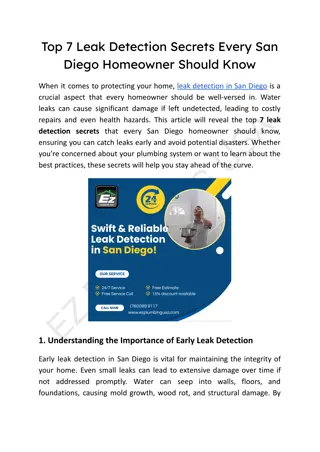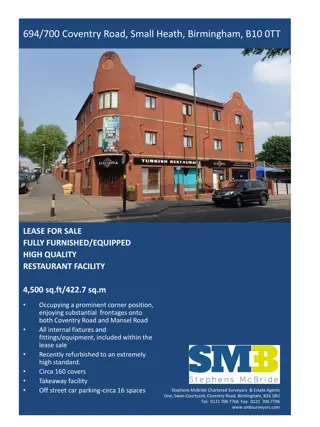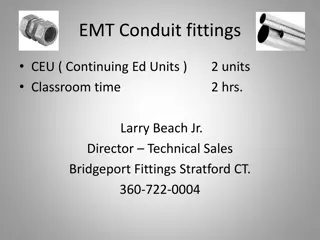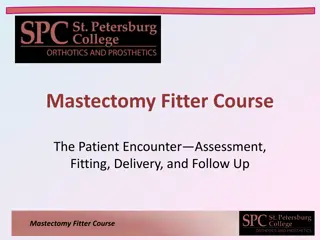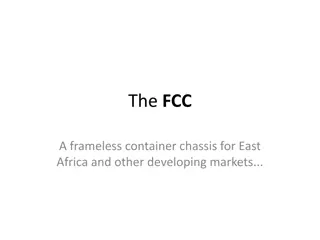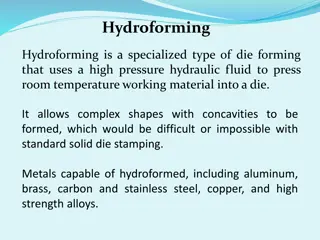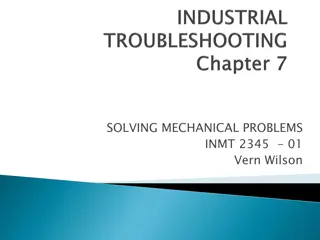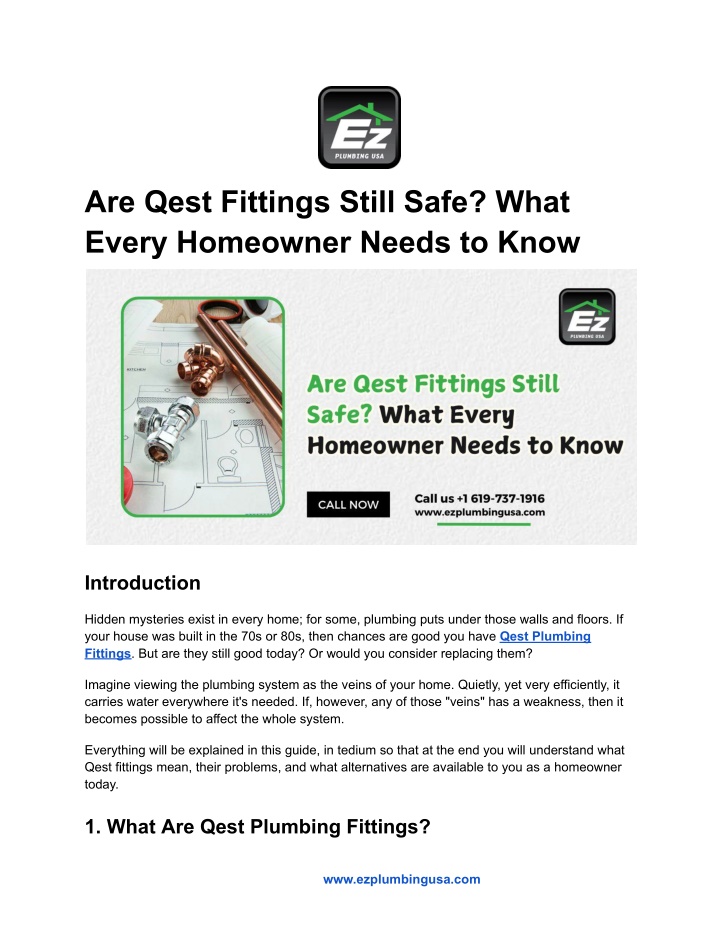
Are Qest Fittings Still Safe_ What Every Homeowner Needs to Know
Are Qest fittings still safe for your homeu2019s plumbing system? Discover the risks, signs of failure, and whether it's time to replace these aging components. Protect your home and avoid costly water damage with this essential homeowner guide. Con
Download Presentation

Please find below an Image/Link to download the presentation.
The content on the website is provided AS IS for your information and personal use only. It may not be sold, licensed, or shared on other websites without obtaining consent from the author. If you encounter any issues during the download, it is possible that the publisher has removed the file from their server.
You are allowed to download the files provided on this website for personal or commercial use, subject to the condition that they are used lawfully. All files are the property of their respective owners.
The content on the website is provided AS IS for your information and personal use only. It may not be sold, licensed, or shared on other websites without obtaining consent from the author.
E N D
Presentation Transcript
Are Qest Fittings Still Safe? What Every Homeowner Needs to Know Introduction Hidden mysteries exist in every home; for some, plumbing puts under those walls and floors. If your house was built in the 70s or 80s, then chances are good you have Qest Plumbing Fittings. But are they still good today? Or would you consider replacing them? Imagine viewing the plumbing system as the veins of your home. Quietly, yet very efficiently, it carries water everywhere it's needed. If, however, any of those "veins" has a weakness, then it becomes possible to affect the whole system. Everything will be explained in this guide, in tedium so that at the end you will understand what Qest fittings mean, their problems, and what alternatives are available to you as a homeowner today. 1. What Are Qest Plumbing Fittings? www.ezplumbingusa.com
Qest fittings (often pronounced Quest) are a type of plumbing fitting commonly used in homes built between the 1970s and 1990s. They were typically used in conjunction with polybutylene (PB) pipes, a flexible, plastic-like material that was easy to install and cheap. These fittings connected pipes throughout the home and were usually gray, white, or blue, often with compression-style rings or crimp rings. 2. The Rise of Qest: A Look Back in Time Back in the day, Qest plumbing systems were revolutionary. At a time when copper was expensive and difficult to install, Qest systems offered a quick and affordable solution. Builders loved them, and so did homeowners at least at first. It was the new shiny thing, much like how smartphones changed how we communicate. But, like early cell phones, these fittings had their flaws. 3. Why Were Qest Fittings Popular? Qest systems were widely embraced because they were: Lightweight and flexible Easier to install than copper Cheaper and faster for contractors Corrosion-resistant, at least initially They sounded like a dream come true for homebuilders and for a while, they were. 4. Common Issues Reported with Qest Fittings Unfortunately, over time, many homeowners began to notice problems: Leaks at joints and fittings Stress fractures or cracking Sudden pipe bursts Water damage behind walls or under floors www.ezplumbingusa.com
What started as isolated incidents soon became a nationwide concern. These issues usually took years to show, which meant that by the time leaks happened, the damage was already extensive. 5. Materials Used: Polybutylene and Plastic Concerns The core issue lies in the polybutylene material. It was once considered a miracle material, but exposure to chlorine and other water treatment chemicals caused it to become brittle and fail over time. Imagine a rubber band left out in the sun it may look fine at first but will eventually dry out and snap. That's what happened with many Qest fittings and their accompanying pipes. 6. Are Qest Fittings Still Safe in 2025? So, are Qest plumbing fittings safe today? The answer depends on several factors: If the system has held up without any signs of failure, it may continue to perform. However, many plumbing experts caution that it's only a matter of time before issues develop. Qest systems may still function in some homes, but they re not considered reliable by modern plumbing standards. Most professionals recommend replacing them to prevent costly water damage. 7. The Class-Action Lawsuits and Their Impact In the 1990s, major class-action lawsuits were filed against manufacturers of polybutylene systems, including Qest. The largest, known as the Cox v. Shell Oil lawsuit, led to settlements for thousands of affected homeowners. These legal battles highlighted the widespread nature of failures. Although the lawsuits provided some relief, they also cemented Qest fittings as a cautionary tale in the plumbing world. 8. How to Identify Qest Plumbing in Your Home www.ezplumbingusa.com
Not sure if your home has Qest fittings? Look for: Gray or blue flexible piping Plastic fittings with metal bands Labels like PB2110 or Qest Most homes with Qest were built between 1978 and 1995, so check your home s construction date and inspect visible plumbing in basements, crawlspaces, or utility rooms. 9. Signs You Might Have a Problem Even if your pipes look fine, here are warning signs to watch out for: Unexplained drops in water pressure Water stains on ceilings or walls Mold or mildew growth Unusually high water bills These are often early indicators of slow leaks or degraded pipe connections. Catching them early can save you thousands in repairs. 10. Repair vs. Replace: What s the Best Option? If you're dealing with Qest fittings, you have two main options: 1. Repair small issues temporarily A plumber might patch a single leak, but this is often like putting a band-aid on a broken bone. 2. Replace the system entirely While costly upfront, repiping your home with safer, more reliable materials is the best long-term solution. 11. Modern Alternatives to Qest Plumbing Fittings The plumbing industry has come a long way since Qest. Today, you have options like: www.ezplumbingusa.com
PEX (Cross-linked Polyethylene) Flexible, durable, and affordable Copper Long-lasting and sturdy, but more expensive CPVC A reliable plastic option for hot and cold water Each has its pros and cons, but all are far more reliable than outdated Qest systems. 12. Costs Involved in Replacing Qest Fittings On average, a full home repipe might cost: $4,000 to $10,000, depending on home size, location, and chosen material. Some insurance policies may help if you ve already had leaks or failures. Yes, it's a big investment but compare that to the cost of water damage restoration, and it starts to make more sense. 13. Is DIY Replacement a Good Idea? Unless you have plumbing experience, the answer is no. Replacing Qest plumbing often involves working behind walls, cutting into drywall, and navigating building codes. It's best left to licensed professionals who can guarantee a safe and leak-free system. 14. What Professionals Say About Qest Today Most plumbers agree: Qest plumbing fittings are outdated and unreliable. They re no longer approved in many regions. Contractors usually advise repiping when they find them. Home inspectors may flag Qest systems during real estate transactions. In fact, some home insurance companies even charge higher premiums or deny coverage for homes with Qest plumbing. www.ezplumbingusa.com
15. Conclusion: Should You Be Worried? If your home still uses Qest fittings, it's worth being cautious. While not every system has failed, the track record speaks for itself. Think of it like driving with old tires sure, they might not blow out today, but wouldn t you feel better replacing them? Talk to a licensed plumber, get an inspection, and explore your options. Staying proactive could save your home and your wallet from serious damage. EZ Plumbing USAoffers 24/7 professional plumbing services across San Diego, Orange County, and Riverside. They specialize in leak detection, emergency repairs, and water heater services for homes and businesses. Contact us for more information. View Source- https://ez-plumbing-usa.medium.com/are-qest-fittings-still-safe-what-every-homeowner-needs-to-kn ow-407223828eca www.ezplumbingusa.com
Contact Us EZ Plumbing USA Address - 10320 Camino Santa Fe STE E, San Diego, CA 92121, United States Phone - +1 619-737-1916 Mail - sales@ezplumbingusa.com Web - www.ezplumbingusa.com www.ezplumbingusa.com



